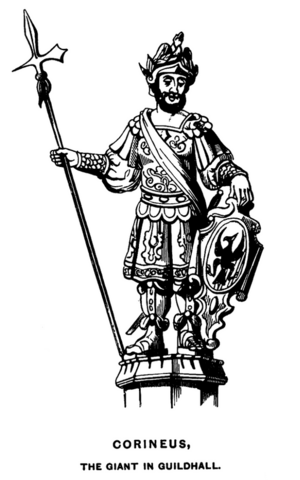Corineus facts for kids

Corineus was a famous warrior in old British legends. He was known for fighting giants and is said to have founded Cornwall. People in the Middle Ages believed his story was part of Britain's early history.
Contents
Corineus in History of the Kings of Britain
In a book from 1136 called History of the Kings of Britain by Geoffrey of Monmouth, Corineus was a brave leader. He led a group of people who were descendants of the Trojans. These Trojans had left their home after the Trojan War. Corineus was known for being very courageous and a great fighter, especially against giants. He even boasted about killing many giants!
Corineus and his people met Brutus, who was also a Trojan prince. Brutus had been exiled from Italy. Corineus and his group decided to join Brutus on his travels.
Adventures in Gaul and Britain
While traveling through Gaul (which is now France), Corineus caused a war. He hunted in the forests of King Goffarius without permission. In the big battle that followed, Corineus was incredibly strong. He fought with a battle-axe and defeated thousands of enemies by himself!
After winning this battle, the Trojans sailed to an island called Albion. Brutus renamed it Britain, after himself. Corineus settled in the area that is now Cornwall. At that time, Cornwall was full of giants. Brutus and his army killed most of them. However, they kept the giant leader, Goemagog, alive for a special wrestling match with Corineus.

During the wrestling match, Goemagog broke three of Corineus's ribs. Corineus became very angry! He picked up the giant, ran to the coast, and threw him from a high rock into the sea. The sharp rocks below tore the giant apart.
Corineus and the Naming of Cornwall
Corineus became the first legendary ruler of Cornwall. The region was named after him. After Brutus died, Britain was divided among his three sons. One son, Locrinus, was supposed to marry Corineus's daughter, Gwendolen. But Locrinus fell in love with another princess instead.
Corineus was very upset and threatened war. To keep the peace, Locrinus married Gwendolen. However, he secretly kept the other princess as his partner. After Corineus died, Locrinus left Gwendolen. Gwendolen then gathered an army from Cornwall and fought against Locrinus. Locrinus was killed in battle. Gwendolen then threw the other princess and her daughter into the River Severn.
Where the Story Comes From
The name Corineus might have come from a character named Corynaeus in an old Roman poem called the Aeneid. This character was a follower of the hero Aeneas. Some historians think Geoffrey of Monmouth chose this name because it sounded like "Cornwall."
There's also a similar story in ancient Greek myths. The hero Hercules fought a giant named Antaeus. Hercules defeated Antaeus by lifting him off the ground, which was the source of his strength. This might have inspired the story of Corineus fighting Gogmagog.
Gogmagog's Leap
The famous fight between Corineus and Gogmagog ended at a place called "Goemagog's Leap." Geoffrey of Monmouth said this place kept its name for a long time. Later writers sometimes called it Langoëmagog.
Some old stories say the fight happened near Totnes, in Devon. Other stories placed the "leap of Gogmagog" at Dover.
Giants on Plymouth Hoe
A researcher named Peter Bartrum suggested that the story might have come from giant figures carved into the grass at Plymouth Hoe. The first mention of these figures was in 1495. People would regularly re-cut and clean them. They called these figures Gogmagog.
An old writer named Richard Carew thought the fight might have started near Totnes but ended at Plymouth Hoe. He believed the figures showed Corineus and Gogmagog. He wrote about them in 1602: "upon the Hawe at Plymmouth, there is cut out in the ground, the pourtrayture of two men... whom they terme Gog-Magog."
These figures were destroyed in 1665 when the Royal Citadel was built. In 2021, an artist painted new figures of Corineus and Gogmagog on a grassy bank near the Citadel, inspired by the old story.
Later Stories About Corineus
The tale of Corineus was kept alive by many writers over the years. These included famous authors like Michael Drayton and John Milton.
In a play from 1595 called Locrine, Corineus is a main character. He is described as being found by Brutus and fighting other enemies. In this play, Corineus lives for more than 87 years. He dies from a wound he got in battle.
Some stories even say Corineus was originally named Troenius. They claim he was given the western part of Britain, from Torbay to Land's End, by Brutus. From this area, he changed his name to Corineus.
As for Corineus's size, some old texts say he was the largest of Brutus's crew. One source even claimed Corineus was 12 cubits tall, which is about 18 feet!
There's also a local folk story that says Corineus founded the city of Quimper in France.
See also
- Corinius
- Cornish wrestling

